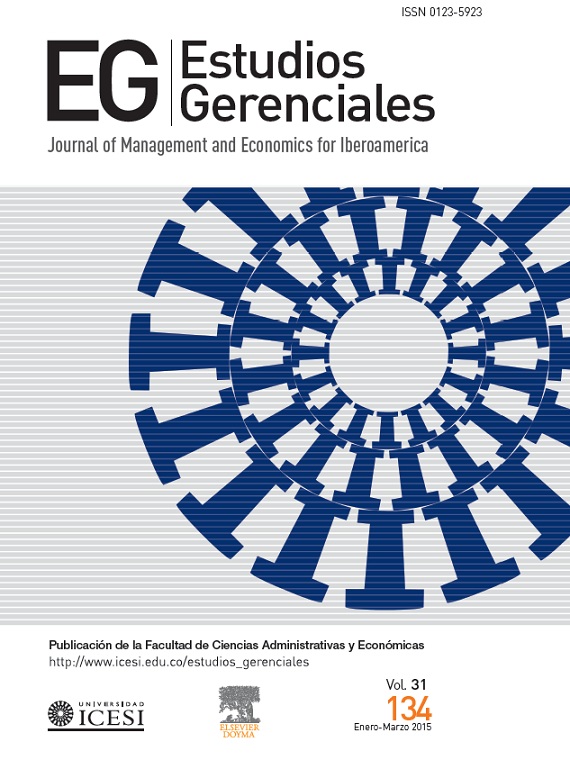Análisis del tamaño de empaque en la cadena de valor para minimizar costos logísticos: un caso de estudio en Colombia
DOI:
https://doi.org/10.1016/j.estger.2014.06.009Keywords:
Optimización, Empaques, Caso de estudio, Cadena de valorAbstract
El presente artículo es un caso de estudio aplicado a una empresa colombiana de consumo masivo para minimizar los costos relacionados con sus operaciones logísticas al utilizar diferentes tamaños de empaque. Se formularon 2 modelos de optimización: uno para determinar los 5 tamaños de empaque secundario que disminuyen la necesidad de apertura para atender los pedidos recibidos, y otro para definir cuáles de esos tamaños de empaques son los más apropiados para atender cada canal de venta, minimizando el costo logístico total asociado. El análisis muestra hallazgos útiles para la atención de diversos canales, donde la optimización en la definición de los tamaños de empaques secundarios produjo una reducción promedio del 8,2% del costo logístico total de la empresa analizada.
Downloads
References
Azzi, A., Battini, D., Persona, A. y Sgarbossa, F. (2012). Packaging design: General framework and research agenda. Packaging Technology and Science, 25(8), 435–456.
DANE. (2007). PIB per cápita corriente y constante 2000-2007. Recuperado el 31 de agosto de 2013 de: http://www.dane.gov.co/index.php/cuentas-economicas/cuentas-departamentales/79-cuentas-nacionales/cuentas-nacionalesdepartamentales/2830-pib-percapita-corrientes-y-constantes-2000-2007p
De la Motte, P. y Persson, P. (2009). A packaging cost model for Ericsson AB [master thesis]. Lund, Sweden: Department of Design Sciences, Faculty of Engineering, Lund University.
García, J. y Prado, J. (2006). La mejora de la eficacia en la cadena de suministro mediante el adecuado diseño de envases y embalajes. Universia Business Review, 10, 80–95.
Ge, G. (1996). Efficient packaging design in logistics. Packaging Technology and Science, 9(5), 275–287.
Hellström, D. (2007). On interactions between packaging and logistics–Exploring implications of technological developments [doctoral dissertation]. Lund, Sweden: Department of Design Sciences, Division of Packaging Logistics, Lund University.
Hellström, D. y Saghir, M. (2007). Packaging and logistics interactions in retail supply chains. Packaging Technology and Science, 20(3), 197–216.
Herard, P. y Robson, N. (1992). Using suitable packaging for exports of floricultural products. International Trade Forum, 4, 4–13.
Hughes, P. (1996). Exporting furniture: Getting the packaging right. International Trade Forum, 1, 8–16.
Lee, S. G. y Lye, S. W. (2003). Design for manual packaging. International Journal of Physical Distribution & Logistics Management, 33(2), 163–189.
Leung, S. Y. S., Wong, W. K. y Mok, P. Y. (2008). Multiple-objective genetic optimization of the spatial design for packing and distribution carton boxes. Computers & Industrial Engineering, 54(4), 889–902.
Lockamy, A. (1995). A conceptual framework for assessing strategic packaging decisions. International Journal of Logistics Management, 6(1), 51–60.
Mollenkopf, D., Closs, D., Twede, D., Lee, S. y Burgess, G. (2005). Assessing the viability of reusable packaging: A relative cost approach. Journal of Business Logistics, 26(1), 169–197.
Organización para la Cooperación y el Desarrollo Económico (OCDE), Comisión Económica para América Latina y el Caribe (CEPAL) y Banco de Desarrollo de América Latina (CAF) (2013). Perspectivas económicas de América Latina 2014: logística y competitividad para el desarrollo. Recuperado el 2 de mayo de 2014 de: http://www.eclac.cl/publicaciones/xml/2/51612/Perspectivaseconomicas2014.pdf
Pålsson, H., Finnsgård, C. y Wänström, C. (2012). Selection of packaging systems in supply chain from a sustainability perspective: The case of Volvo. Packaging Technology and Science, 26(5), 289–310.
Saghir, M. (2004). The concept of Packaging Logistics. In Proceedings of the Fifteenth Annual POMS Conference, Cancun, April 30-May 3.
Sanders, R. T. y Green, K. C. (1989). Proper packaging enhances productivity and quality. Industrial Engineering, 21(8), 51–55.
Tápler, C. y Csík, A. (2010). Packaging unit quantity optimization. Acta Technica Jaurinensis Series Logistica, 3(3), 257–266.
Wagner, H. M. (2002). And then there were none. Operations Research, 50(1), 217–227.
Wang, P. (2010). Pack optimization problem: Models and solution methods [doctoral dissertation]. Raleigh, NC, United States of America: North Carolina State University.
Wen, N., Graves, S. C. y Ren, Z. J. (2012). Ship-pack optimization in a two-echelon distribution system. European Journal of Operational Research, 220(3), 777–785.
Yan, X. S., Robb, D. J. y Silver, E. A. (2009). Inventory performance under pack size constraints and spatially-correlated demand. International Journal Production Economics, 117(2), 330–337.
Yesodha, R. y Amudha, T. (2012). A comparative study on heuristic procedures to solve bin packing problems. International Journal in Foundations of Computer Science & Technology, 2(6), 37–49.
Yin, R. K. (2003). Case study research: Design and methods (3.a Ed.). Thousand Oaks, CA: Sage Publications.
Downloads
Published
Issue
Section
License
Articles are the sole responsibility of their authors, and will not compromise Icesi’s University principles or policies nor those of the Editorial Board of the journal Estudios Gerenciales. Authors authorize and accept the transfer of all rights to the journal, both for its print and electronic publication. After an article is published, it may be reproduced without previous permission of the author or the journal but the author(s), year, title, volume, number and range of pages of the publication must be mentioned. In addition, Estudios Gerenciales must be mentioned as the source (please, refrain from using Revista Estudios Gerenciales).








